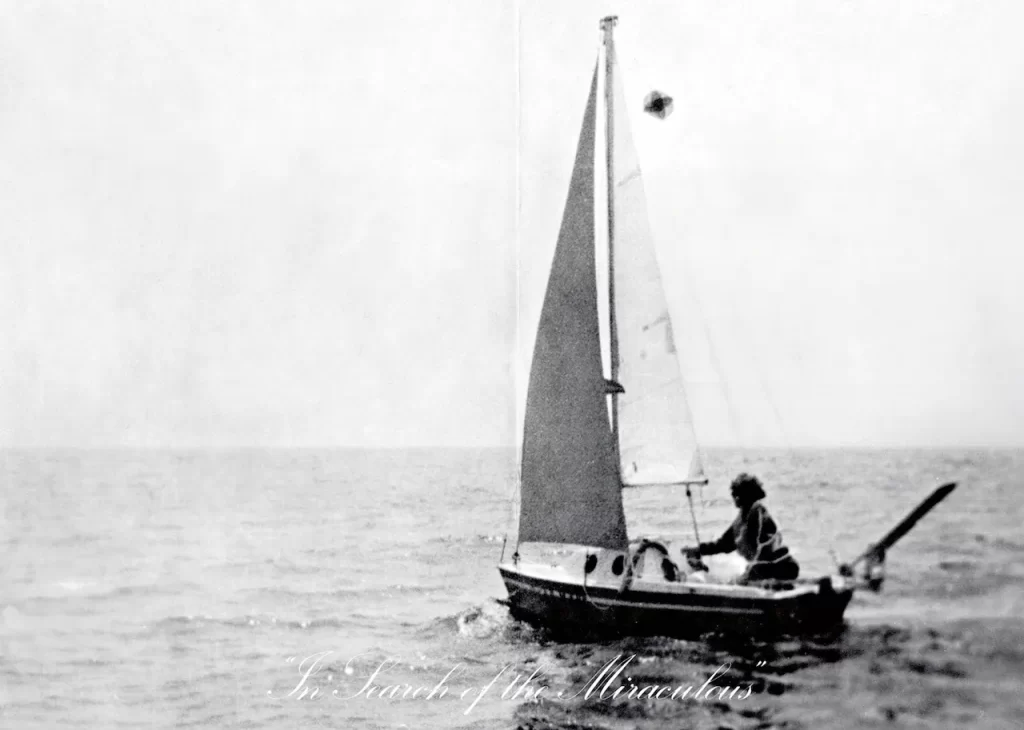Bound to the Miraculous
Back to Projects
Starting Date – November 7, 2023
In 1975, Dutch artist Bas Jan Ader, embarked on a sailing trip from Cape God (USA) to Groningen (NL) on his own. Bas Jan’s trip was part of what was to become the triptych ‘In Search of the Miraculous’. Six months after his departure, his boat was found. The ‘Ocean Wave’ was half submerged off the coast of Ireland. Bas Jan had disappeared.
Like with Bas Jan Ader’s original, this project aims to evoke the heroic and the tragic. The ever-changing beauty and danger of the open sea as a metaphor for our life-world. The tiny boat being a metaphor for our fragile existence, floating perilously on this sea of circumstance.
“Bound to the Miraculous” is a collaborative endeavour by Cradle Lab at Breda University of Applied Sciences, Studio Edward Clydesdale Thomson, and Utrecht University’s Oceanology department. This project reimagines Dutch artist Bas Jan Ader’s 1975 solo voyage in a contemporary context using a simulated ocean developed in Unreal Engine 5 (UE5). The project serves as a digital narrative, reflecting the interplay between human endeavour and the formidable forces of nature, set against the backdrop of a changing climate.
The simulation of Ader’s journey underscores not just the personal, existential struggle of the individual against the elements, but also encapsulates a collective narrative on the impact of human actions on the climate. It highlights how, over the past four decades, our growing awareness of environmental issues has brought to light the material effects of human activity on weather patterns. This is poignantly illustrated by the increasing severity of Atlantic storms, making the original “Ocean Wave” voyage not just a tale of personal resilience but also a metaphor for the collective precariousness of humanity in the face of climate change.

By revisiting Ader’s voyage, “Bound to the Miraculous” seeks to evoke a sense of the heroic and tragic, while fostering a dialogue on climate, weather, pollution, data, history, and endurance. The project asserts the relevance of retelling this story in our times, as it resonates with the shifted meaning from an individual’s struggle to a shared global vulnerability, underscoring the pressing need for collective action and awareness.
The Cradle Lab team set out to develop a real-time ocean simulation that could accurately depict various weather conditions, a day/night cycle, and respond to live weather data. Challenges included integrating vast, complex data sets into a responsive and emotionally resonant simulation. The team aimed to answer how one could translate scientific data into an engaging narrative experience. Through iterative development, collaboration with marine experts, and integration of a marine weather API (https://stormglass.io/), the team developed a virtual environment where a simulated boat journey reflects the unpredictable nature of oceanic travel.
As a prototype, this phase of the project marks the beginning rather than the endpoint. The project’s future roadmap includes refining the simulation with more detailed data visualisations and interactivity. Upcoming enhancements encompass improved data integration, development of a mobile application for live streaming, and real-time tracking of the boat’s journey across the Atlantic through map visualisations.
Feedback on the prototype has been favourable, prompting Studio Edward Clydesdale Thomson to proceed with fundraising for the next development phase. The project’s inclusion in the Groningen museum’s 2025 exhibition schedule highlights its potential for broader public engagement.
The current phase sets a precedent for narrative depth combined with technological advancement. Future iterations will focus on enhancing the ocean simulation, the boat’s navigation response system, and integrating a Marine Traffic API to simulate encounters with other vessels, enriching the user experience with elements of real-world maritime traffic.
The “Bound to the Miraculous” project was brought to life using an array of advanced tools and technologies, with Unreal Engine 5 (UE5) at the core of its development. UE5 enabled us to leverage its cutting-edge graphics and physics engine to create a good-looking and dynamically responsive oceanic environment.
The specific tools and technologies used included:
Research involved exploring UE5 capabilities in simulating visual and physical maritime conditions, integrating a weather API for real-time data, and developing a user interface for displaying this data.
Throughout the “Bound to the Miraculous” project, our art lead delved into the visual representation of weather and ocean conditions within UE5, focusing on the realism of day/night cycles, sail cloth simulation, and the aesthetic effects of post-processing to evoke the atmosphere of a sea voyage in B&W. The meticulous recreation of Bas Jan Ader’s sailboat in 3D served as a testament to historical accuracy and visual fidelity.
On the technological front, the developers embarked on integrating live global weather data through the StormGlass API, translating this data into a visually appealing metrics screen with a custom UI. This included the development of a ‘captain’s log’ feature, reflecting real-time weather events and a journey management system that adapted to the integrated environmental systems. The encounter vessel system, boat management, audio integration, and camera setup system research were all geared towards creating a seamless and immersive simulation experience.
Outcomes from this research are informing other projects, such as “Procedural Ocean View,” by applying the technical insights to create immersive 3D and VR maritime experiences.
The research conducted for “Bound to the Miraculous” has laid a foundation for future ocean simulation projects, reinforcing Cradle Lab’s commitment to leverage R&D for innovative and educational experiences in the digital and real-world realms.
Would you like more news on this project in general, please contact: